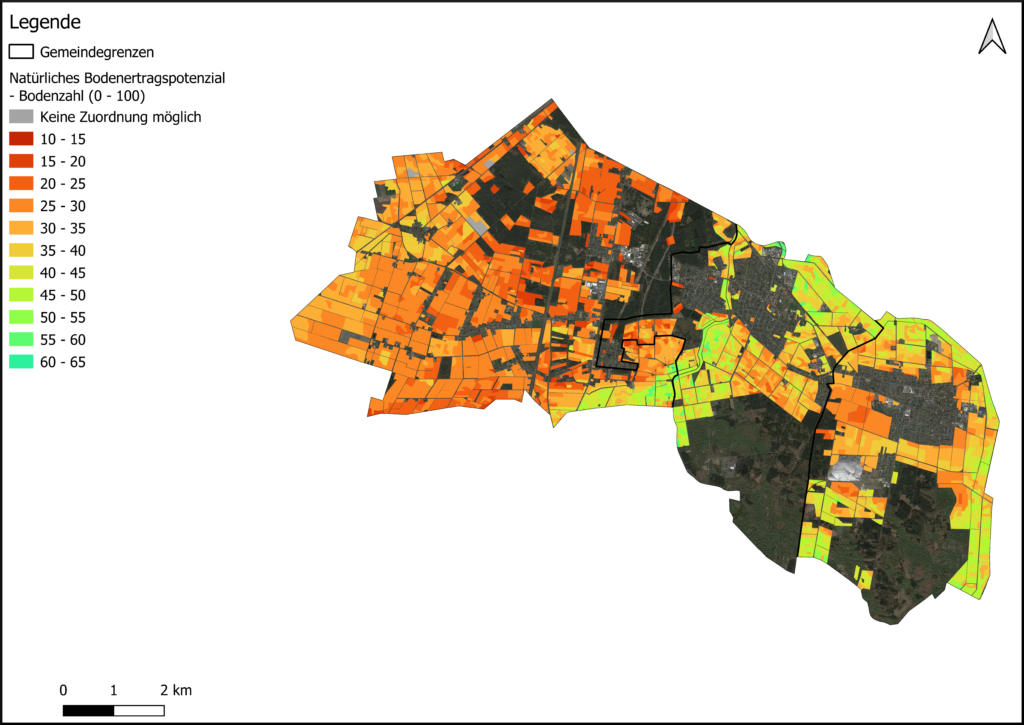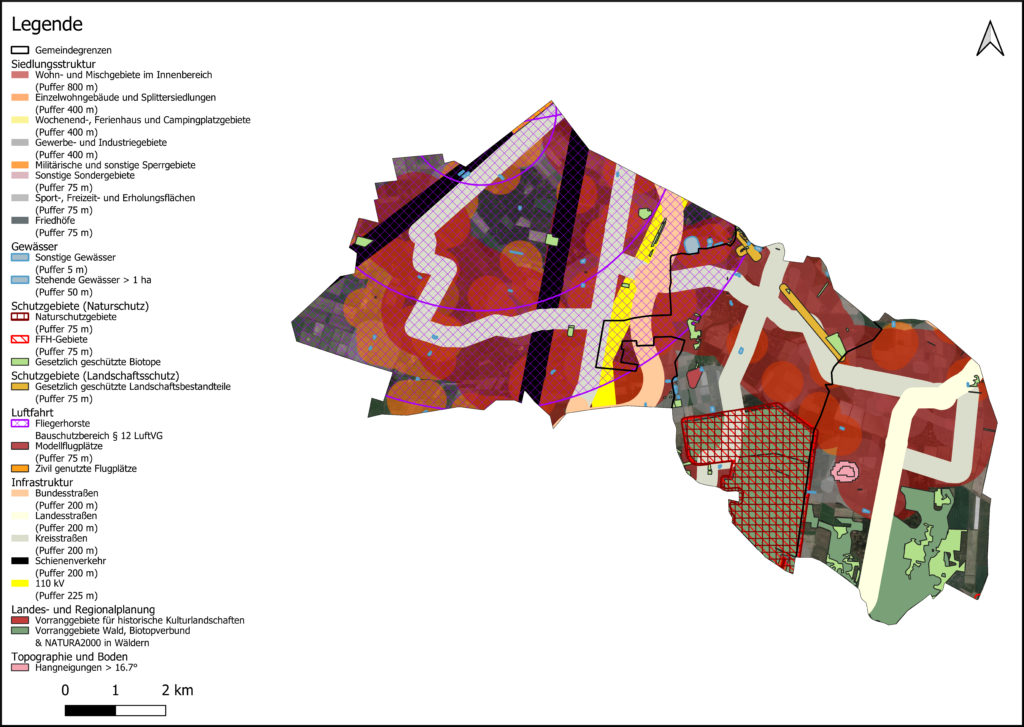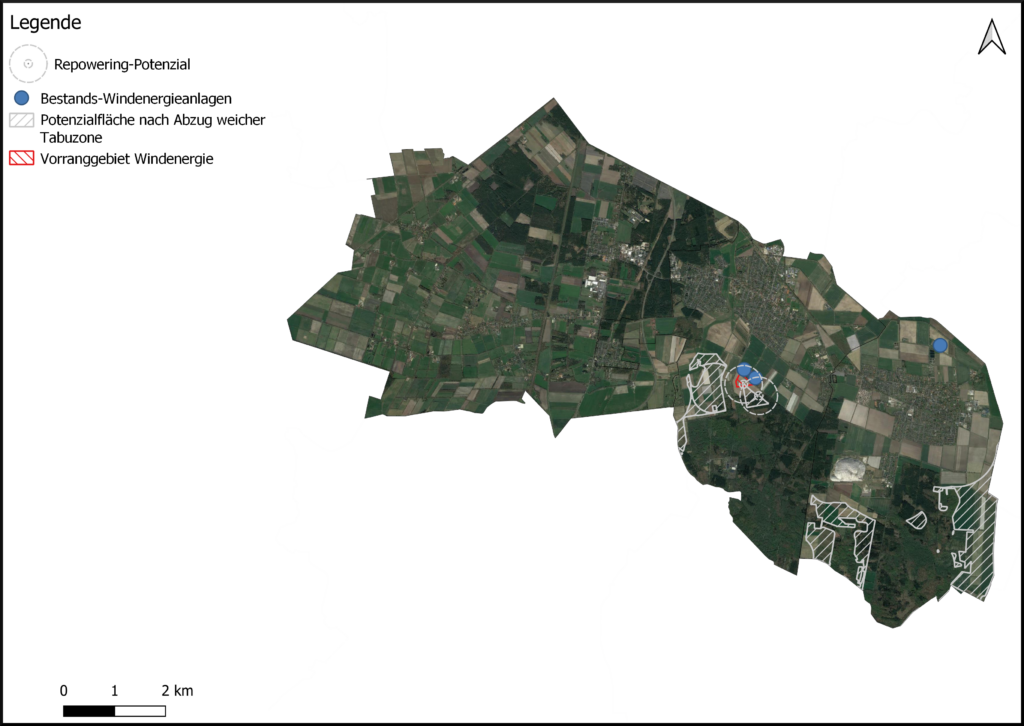Location concepts for planning authorities
Independent potential area analyses for ground-mounted photovoltaics and wind energy!
What significance does the energy transition have for municipal planning authorities?
The German government wants to rapidly accelerate the expansion of renewable energies. For example, more than 215 GW of photovoltaic capacity is to be installed by 2030 and 2 per cent of the federal area is to be designated for wind energy by 2032.
Local planning authorities have a key role to play in the energy transition, as they ultimately implement the federal government’s targets for meeting the expansion targets. In view of this crucial role, there is a need for action on the part of municipal planning authorities.
As a planning office for potential area analyses and site concepts, Nefino has set itself the task of supporting municipal planning authorities throughout Germany in the spatially compatible expansion of renewable energies – neutrally, quickly and reliably.
By identifying suitable and spatially compatible sites for ground-mounted photovoltaic and wind energy plants, Nefino gives local planning authorities the opportunity to take the energy transition into their own hands.

How can cities and municipalities benefit from the energy transition?
In addition to contributing to climate protection, municipal planning authorities can also benefit financially from the energy transition.
The Renewable Energy Sources Act (EEG) allows system operators to pay cities and municipalities up to 0.2 cents per kilowatt hour of electricity generated. In some federal states, such a payment is even mandatory. This income can be used, for example, for social infrastructure, nature conservation and climate protection or to promote cultural or educational projects.

For wind energy, this results in additional income for municipalities of between €20,000 and €40,000 per plant per year for modern wind turbines.
For ground-mounted photovoltaic systems, the income for local authorities for an average system is around €2000 per hectare per year.
In addition, the expansion of local renewable energies can bring further economic benefits such as income from trade tax, lease income and through the financial participation of citizens in the energy parks. This strengthens local acceptance for the expansion of renewable energies.
As a municipal planning authority, take the expansion of renewables into your own hands and benefit from lucrative income and control of the expansion in your interests!
Energy generation without competition for space? We analyse the best locations for special solar systems such as agri, floating, moor and car park PV for you. For more information on the analyses and backgrounds of the individual solar systems, follow the button!
Nefino supports your municipality in the spatially compatible
expansion of renewable energies!
Open-space photovoltaics
In the area of ground-mounted photovoltaics, planning sovereignty lies with the municipal planning authority. However, in order to prevent competing uses, particularly with agriculture, the local planning authority should control the expansion in a targeted manner.
To this end, we first develop a catalogue of criteria in close consultation with the planning authority, which takes into account the technical and legal framework as well as local conditions. In addition to the exclusion criteria, restriction and favour criteria are also included in the analysis. A particular focus is placed on identifying areas that are eligible for subsidies for ground-mounted photovoltaics under the Renewable Energy Sources Act, as well as areas that are privileged under Section 35 (1) No. 8 b) BauGB.


Location concepts for wind energy
As a result of the amendment to the Wind Area Requirements Act, the majority of regional plans must be adapted by the planning authorities and the area for wind energy expanded. The land utilisation plan must be adapted on the basis of the priority areas for wind energy identified in the regional plan.
The towns and municipalities are therefore directly affected by these plans. It is therefore in the interest of the municipal planning authorities to identify the most spatially compatible areas within their territory on their own initiative. In this way, the best areas from the point of view of the municipal planning authorities can be actively incorporated into the planning process from the outset and their interests in the expansion of wind energy can be represented.
Repowering potential area analyses
In addition to the potential for the addition of new wind turbines, we also analyse the repowering potential of existing turbines. In our extensive database, we have stored information on the operator and age of all wind turbines in Germany, among other things.
By identifying the existing turbines within the identified potential areas, we can derive the repowering potential. In this way, communities benefit from the replacement of ageing wind turbines at established locations with more powerful new turbines.


Investor A: Area is not part of the potential area. The application can be rejected directly.
Investor B: Area is part of the potential area, but has few favourable criteria and is located near a settlement. The enquiry should be examined again in detail.
Investor C: The area is part of the potential area backdrop and has a large number of favourable criteria. Application can be accepted in principle.
Analyses of individual areas
In addition to overall spatial location concepts, we also carry out analyses for individual areas. If, for example, an area analysis is available at a macroscopic level or a prioritisation of areas for a planning area, we provide support with a detailed analysis of the individual areas identified in the first step.
In this process, area profiles are created in which all relevant information for the initiation of land-use planning is presented with the help of maps.
Nefino supports municipal planning authorities in their endeavours to achieve spatially compatible management!
What makes us special
Many years of expertise in the identification of potential areas
As one of the largest independent service providers, we carry out analyses of potential sites for municipal planning authorities throughout Germany. In doing so, we identify the most spatially suitable areas on the basis of professional, legal and technical exclusion criteria.
We include all relevant geodata in our identification, from individual distances to residential areas to arable yield potential and height restrictions for wind turbines.
Neutral decision-making basis
Based on our potential area analysis, we carry out an independent evaluation of the areas using numerous restriction and favourability criteria. We provide the planning authority with comprehensive map material and a solid geodata basis so that it can continue to work independently.


Time frame
We are characterised by a particularly fast processing time of a few weeks and are far below the usual processing times in the industry. This is made possible by our comprehensive geodatabase, which we always keep up to date. By working with state-of-the-art geoinformation systems, we achieve particularly high-quality and precise results.
Interdisciplinary team
With over 30 highly motivated and talented employees, we are an innovative and versatile team. As a science spin-off of the University of Hanover, our work centres on the pursuit of efficient research transfer from science to practice.
Our goal as geographers, engineers and computer scientists is to contribute to the success of the energy transition through interdisciplinary collaboration with innovative digital solutions. You can find more information about us on our homepage and LinkedIn.
Take advantage of the opportunities that arise from active participation in the energy transition and actively shape a sustainable future for your municipality with Nefino.
Get in touch with us today!
Arrange an online appointment with one of our experts or give us a call!